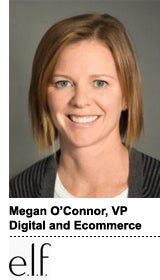 While many brick-and-mortar retailers grapple with bringing their businesses online, cosmetics brand e.l.f. did things in reverse.
While many brick-and-mortar retailers grapple with bringing their businesses online, cosmetics brand e.l.f. did things in reverse.
After 11 years in ecommerce, e.l.f. (that stands for Eyes Lips Face) is now expanding its offline footprint, said Megan O’Connor, VP of digital and ecommerce at e.l.f Cosmetics. In the past year, e.l.f. has opened three flagship stores in the New York area in addition to mass distribution deals it has secured with Target and Walmart.
All clichés aside, e.l.f. wants to develop an omnichannel strategy. But when O’Connor started at the cosmetics brand a year ago, that was certainly not the case. Before it tackled in-store measurement, e.l.f. needed to get its digital house in order.
“We had a search agency, a separate affiliate agency and we were testing and learning in display,” she said. “One of our objectives was to look at attribution over time and across channels.”
Three years ago, e.l.f. partnered with display retargeter mediaFORGE, which Japanese ecommerce company Rakuten LinkShare acquired around the same time.
“From our perspective, insights you get from direct response are sometimes more important than demographics or psychographics, which tell us who we think ‘she’ is, but what matters to us is how often you see [our message] and where you see it,” O’Connor added.
A year ago, e.l.f. started using Rakuten Marketing’s media attribution tool, Cadence, which Rakuten upgraded Thursday into an omnichannel attribution platform it’s now calling Cadence Essential.
This upgrade bolstered Cadence’s offline attribution capabilities, gaining functionality from multitouch attribution vendor DC Storm, which Rakuten Marketing acquired last May. Consequently, Cadence added direct mail, call center and mobile measurement to its online mix.
Using Cadence, e.l.f. saw a 40% increase in repeat purchases when combining messaging across paid channels including branded search, affiliate and display retargeting.
“One thing that’s super interesting for me is how these different channels support each other,” said O’Connor. “We worked with some agencies who were great strategic partners, but lacked the tools to improve the efficiency of the program. We liked that Rakuten had those strategic services, but managed and owned some of the channels as well.”
Rakuten’s focus on measurement is similar to that of other ad tech providers. AOL and Google acquired multitouch attribution vendors Convertro and Adometry, respectively, in 2014 and Facebook just updated its own Conversion Lift tool.
Rakuten’s attribution platform now goes beyond measuring performance and examines the path to purchase. This addition includes measuring average journey length and order value for both converting and non-converting consumers.
 Although Rakuten Marketing claims its measurement tool is not limited only to Rakuten Marketing-managed media channels, it is not integrated with third-party providers (e.g., Adobe or Google Analytics). That said, it claims it could do so in individual client instances based on need.
Although Rakuten Marketing claims its measurement tool is not limited only to Rakuten Marketing-managed media channels, it is not integrated with third-party providers (e.g., Adobe or Google Analytics). That said, it claims it could do so in individual client instances based on need.
“Companies are writing huge checks to understand what their vendors are doing with their money, but we think attribution should be a commodity,” said Tony Zito, president of Rakuten Marketing.
Cadence Essential is available at little to no cost to Rakuten customers, depending on how granular they’d like to get in their respective campaign.
““This wasn’t just built on clicks or conversion, but really ties cost into the picture as well,” Zito said.















